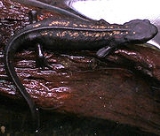
Sword-tail Newt
Encyclopedia
The Sword-tail newt has recently been placed on Japan's Red List of Threatened Amphibians. This newt has a very small range and can only be found in some of the southernmost islands of Japan. Sometimes, Sword-tail newts are called Fire-bellied Newts, not to be confused with the common Chinese
and Japanese
species, because of their bright orange bellies which serve as a warning to predators that they are poisonous. They can be differentiated from these two species by their large size, broader head and (against Japanese Fire-Bellies) smoother skin.
These newt ranges from brown black above, occasionally with an orange dorsal stripe. Some individuals may have light spotting or speckling on their back.
Sword-tailed newts grow from 5 - 7 inches and are considered to be the largest living members of their genus. . Females and males look significantly different in appearance. Females have much longer tails that are actually longer than the rest of their bodies. Males’ tails are much shorter and sometimes display a whitish sheen during breeding season.
This newt makes it habitat in slow, cool, stagnant bodies of water. They are commonly found in man made structures such as rice paddies, road-side ditches, and cattle waterholes.
There are two known subspecies of Sword-tailed newt, Cynops ensicauda ensicauda and Cynops ensicauda popei. Due to the subtropical climate of its native habitat, it is more tolerant of high temperatures than other Cynops.
The Sword-tailed newt has no predators so deforestation and land development are the main reason for their endangerment.
Studies have shown that breeding places are being frequented by only a fourth of the Sword Tail Newt population that was breeding fourteen years ago. This lack of breeding is another key reason for them becoming endangered. Many of their breeding places are in roadside ditches and gutters, which can lead to them being run over. Sword-tailed newts are extremely territorial, thus making moving there breeding places difficult.
Chinese Fire Belly Newt
The Chinese Fire Belly Newt is a small black newt, with bright orange aposematic coloration on the ventral side. Cynops orientalis is commonly seen in pet stores, where it is frequently confused with the Japanese Fire Belly Newt due to similarities in size and coloration. C...
and Japanese
Japanese Fire Belly Newt
The Japanese Fire Belly Newt is a common Asian newt. It is commonly confused with the Chinese Fire Belly Newt due to similarities in coloring and size, and most newts sold as Japanese Fire Bellys are likely to be the more commonly collected Chinese Fire Belly instead.-Description:This newt is...
species, because of their bright orange bellies which serve as a warning to predators that they are poisonous. They can be differentiated from these two species by their large size, broader head and (against Japanese Fire-Bellies) smoother skin.
These newt ranges from brown black above, occasionally with an orange dorsal stripe. Some individuals may have light spotting or speckling on their back.
Sword-tailed newts grow from 5 - 7 inches and are considered to be the largest living members of their genus. . Females and males look significantly different in appearance. Females have much longer tails that are actually longer than the rest of their bodies. Males’ tails are much shorter and sometimes display a whitish sheen during breeding season.
Habitat and distribution
The sword-tailed newt is only found on the Ryukyu Archipelago, and island chain of the southern coast of Japan, as well as on many smaller surrounding islands.This newt makes it habitat in slow, cool, stagnant bodies of water. They are commonly found in man made structures such as rice paddies, road-side ditches, and cattle waterholes.
There are two known subspecies of Sword-tailed newt, Cynops ensicauda ensicauda and Cynops ensicauda popei. Due to the subtropical climate of its native habitat, it is more tolerant of high temperatures than other Cynops.
The Sword-tailed newt has no predators so deforestation and land development are the main reason for their endangerment.
Studies have shown that breeding places are being frequented by only a fourth of the Sword Tail Newt population that was breeding fourteen years ago. This lack of breeding is another key reason for them becoming endangered. Many of their breeding places are in roadside ditches and gutters, which can lead to them being run over. Sword-tailed newts are extremely territorial, thus making moving there breeding places difficult.

